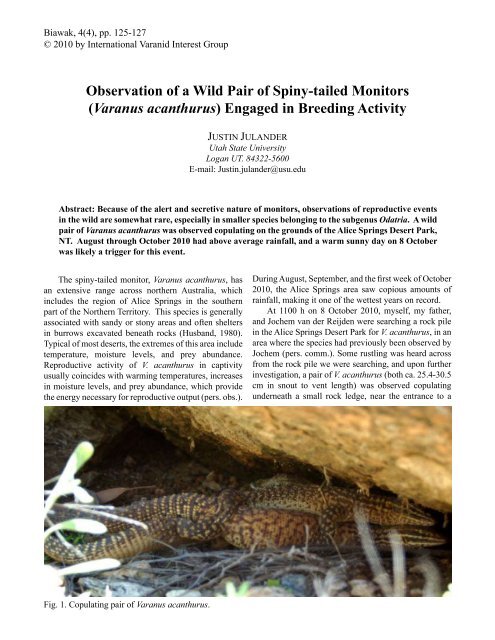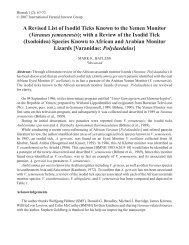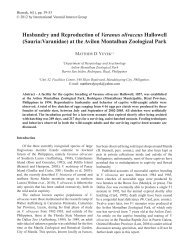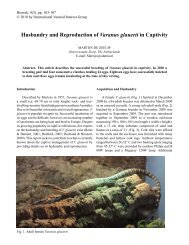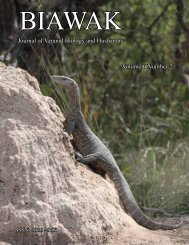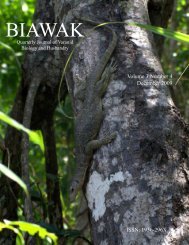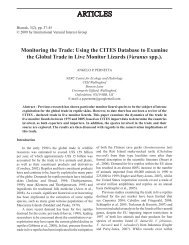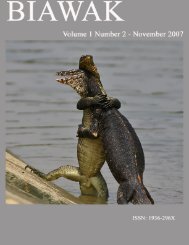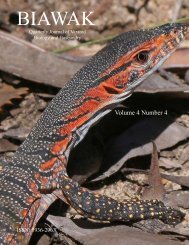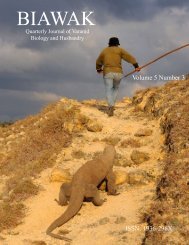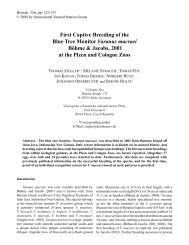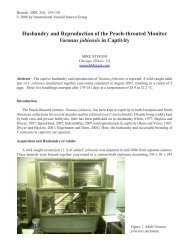Varanus acanthurus - International Varanid Interest Group
Varanus acanthurus - International Varanid Interest Group
Varanus acanthurus - International Varanid Interest Group
You also want an ePaper? Increase the reach of your titles
YUMPU automatically turns print PDFs into web optimized ePapers that Google loves.
Biawak, 4(4), pp. 125-127<br />
© 2010 by <strong>International</strong> <strong>Varanid</strong> <strong>Interest</strong> <strong>Group</strong><br />
Observation of a Wild Pair of Spiny-tailed Monitors<br />
(<strong>Varanus</strong> <strong>acanthurus</strong>) Engaged in Breeding Activity<br />
JUSTIN JULANDER<br />
Utah State University<br />
Logan UT. 84322-5600<br />
E-mail: Justin.julander@usu.edu<br />
Abstract: Because of the alert and secretive nature of monitors, observations of reproductive events<br />
in the wild are somewhat rare, especially in smaller species belonging to the subgenus Odatria. A wild<br />
pair of <strong>Varanus</strong> <strong>acanthurus</strong> was observed copulating on the grounds of the Alice Springs Desert Park,<br />
NT. August through October 2010 had above average rainfall, and a warm sunny day on 8 October<br />
was likely a trigger for this event.<br />
The spiny-tailed monitor, <strong>Varanus</strong> <strong>acanthurus</strong>, has<br />
an extensive range across northern Australia, which<br />
includes the region of Alice Springs in the southern<br />
part of the Northern Territory. This species is generally<br />
associated with sandy or stony areas and often shelters<br />
in burrows excavated beneath rocks (Husband, 1980).<br />
Typical of most deserts, the extremes of this area include<br />
temperature, moisture levels, and prey abundance.<br />
Reproductive activity of V. <strong>acanthurus</strong> in captivity<br />
usually coincides with warming temperatures, increases<br />
in moisture levels, and prey abundance, which provide<br />
the energy necessary for reproductive output (pers. obs.).<br />
During August, September, and the first week of October<br />
2010, the Alice Springs area saw copious amounts of<br />
rainfall, making it one of the wettest years on record.<br />
At 1100 h on 8 October 2010, myself, my father,<br />
and Jochem van der Reijden were searching a rock pile<br />
in the Alice Springs Desert Park for V. <strong>acanthurus</strong>, in an<br />
area where the species had previously been observed by<br />
Jochem (pers. comm.). Some rustling was heard across<br />
from the rock pile we were searching, and upon further<br />
investigation, a pair of V. <strong>acanthurus</strong> (both ca. 25.4-30.5<br />
cm in snout to vent length) was observed copulating<br />
underneath a small rock ledge, near the entrance to a<br />
Fig. 1. Copulating pair of <strong>Varanus</strong> <strong>acanthurus</strong>.
BIAWAK VOL. 4 NO. 4 126<br />
burrow (Fig. 1). Observed copulation took place for<br />
around three minutes while photographs were taken,<br />
being careful not to disturb the pair. The female retreated<br />
down a burrow under the rock, possibly as a result of<br />
our intrusion, leaving the male in place. It remained<br />
there for several minutes tongue-flicking, and was<br />
apparently unaware of or unconcerned by our presence.<br />
The female then emerged from the first burrow, moving<br />
underneath vegetation and rock overhangs to another<br />
burrow situated underneath a large rock approximately<br />
one meter away. The male then moved from the site of<br />
copulation to a sunny spot on the nearest rock to bask<br />
(Fig. 2). Around two minutes after moving to the second<br />
burrow, the female also emerged to bask on a rock<br />
situated between the two burrows (Fig. 3). After basking<br />
for approximately five minutes, the male retreated to a<br />
burrow and the female was left to bask undisturbed (Fig.<br />
4).<br />
Fig. 2. Male V. <strong>acanthurus</strong><br />
basking.<br />
The background color of the female matched the<br />
yellow-orange base color of the surrounding rocks (Fig.<br />
4), whereas the male had a more reddish ground color<br />
(Fig. 2). The dorsal occelli of the female were mostly<br />
interconnected, making for an intricate maze-like<br />
pattern. Spots in the centers of the occelli were present<br />
in the male, but were largely absent in the pattern of the<br />
female. Both animals were fairly robust with fat tails,<br />
suggesting prominent fat reserves or a recent abundance<br />
of prey. This was not surprising, as plentiful amounts<br />
of locusts and other insects were observed throughout<br />
the surrounding area, which are commonly taken by this<br />
species (King, 2008). The burrows appeared to be wellused,<br />
and the surface of the soil was damp from the rain<br />
of the previous week.<br />
Ovaries and ova of V. <strong>acanthurus</strong> have been shown<br />
to increase in size from April to May, remaining enlarged<br />
from June to October, and oviductal eggs were present<br />
Fig. 3. Female V. <strong>acanthurus</strong><br />
basking
127 JULANDER - BREEDING ACTIVITY IN WILD VARANUS ACANTHURUS<br />
Fig. 4. Female (left) and male (right) V. <strong>acanthurus</strong> basking<br />
between August to November (King & Rhodes, 1982).<br />
Based on observations in captivity, V. <strong>acanthurus</strong> has a<br />
gestation period of around two to four weeks (Husband<br />
& Bonnett, 2009). This would place oviposition for the<br />
female V. <strong>acanthurus</strong> in the present report towards the<br />
end of October or early November, thus falling within<br />
the timeframe reported by King & Rhodes (1982).<br />
Acknowledgements- I would like to thank Jochem<br />
van der Reijden of the Alice Springs Desert Park, who<br />
graciously volunteered to show us around.<br />
References<br />
Husband, G.A. 1980. Notes on the nest and hatching of<br />
<strong>Varanus</strong> <strong>acanthurus</strong>. Herpetofauna 11: 29-30.<br />
Husband, G. & M. Vincent. 2009. Monitors. Pp.<br />
484-583. In Swan, M. (ed.), Keeping and<br />
Breeding Australian Lizards. Mike Swan Herp<br />
Books, Lilydale.<br />
King, D. 2008. The diet and foraging strategy of<br />
<strong>Varanus</strong> <strong>acanthurus</strong>. Biawak 2: 11-17.<br />
King, D & L. Rhodes. 1982. Sex ratio and breeding<br />
season of <strong>Varanus</strong> <strong>acanthurus</strong>. Copeia 1982(4):<br />
784-787.<br />
Received: 23 November 2010; Accepted 30 November 2010


